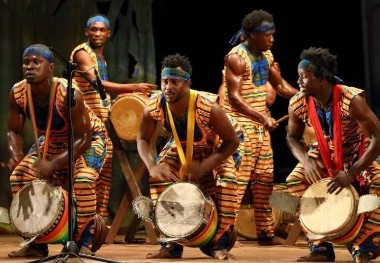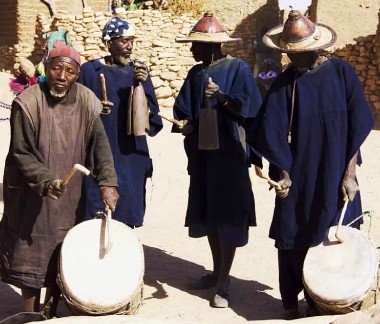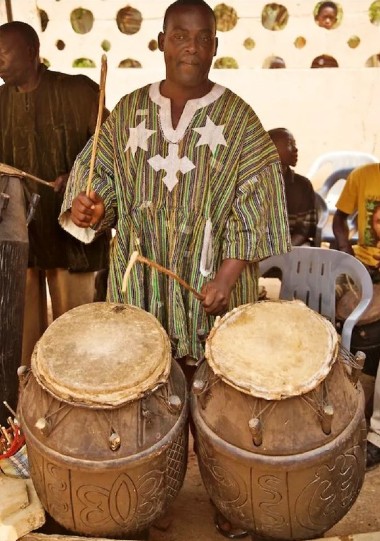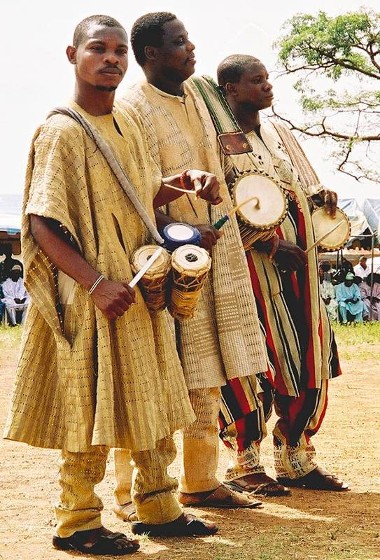the Family of the Kora
Kamale Ngoni / Kora / Gambare
(from Sikasso and Bamako and Kayes, Mali)
 |
Simbingo
(from Ansoumana Kollé and Abbas Dibba aka The Blues Brothers, Jola musicians from Brikama, Gambia)
 |
7-string bow-harp in pentatonic tuning, played by the Jola people in Senegambia who call it also Furakaf |
Simbi
(from Kayes, Mali)
 |
7-string bow-harp in hepatonic tuning,
in Mali it's played by the Bamana the tuning for Jaliya music, play the Carignan (tubular iron bell) |
Bolon / Bolonbata / M'bolon
(from Issa Diabaté, Kela, Manden, Mali)
 |
with 3-4 strings, very percussive sound,
played mainly in Guinée / Mali, used as bass in orchestras those are all originally hunter's harps of the Mande peoples and their neighbors |
Bolongo
(from Senoufo, Korhogo, Côte d'Ivoire)
 |
Senoufo is Ethnic group.
One-stringed calabash harps, plucking the string and tapping the side of the instrument with metal finger rings to establish rhythm. The Poro/Self Defense in dances, which Colobele represents of The Panther dance and acrobatic movements, demonstrating training skill. The Boloy is a symbolic representation of the Poro. Has preserved the Senoufo culture almost intact. |
Donso Ngoni / Kamale Ngoni
(from Mali, Guinée, Côte d'Ivoire)
 |
The Donso Ngoni is the instrument of the traditional hunters societies
in Mali, Guinée and Côte d'Ivoire - Donso means hunting. Hunters use it at their ceremonies to accompany the long, epic stories about famous hunters and generally hunter's mythology. The Kamale Ngoni is technically just about the same, expect that some players prefer to mount guitar tuning pegs instead of the traditional tuning system where the strings are tied up on moveable rings knotted with shoelaces, similar to the Kora. Kamale means youth, so this is the youth's harp to play modern repertoire rather than the traditional songs. The instrument has 6 strings in two parallel planes with pentatonic tuning: C-D-F-G-Bb-c right hand: C-F-Bb, left hand: D-G-c (absolute pitch heights vary of course, right and left hand may be reversed). The Kamale Ngoni is very popular in the Wassoulou music from South Mali (Oumou Sangare features Kamale Ngoni on her recordings). The Kamale Ngoni is played with the left thumb and forefinger and the right thumb. The dampening technique of the right thumb used to stop the sound immediately after plucking the string and the syncopated patterns give the music a swinging drive. |
Goni
(from Omar Diallo, Bobo Dioulasso, Burkina Faso)
 |
The Goni is played by Dioula people of Burkina Faso.
The instrument is very similar to Kamale Ngoni, though somewhat larger. The tuning is also pentatonic: D-F-G-A-c-d-f-g left hand: D-G-c-f, right hand: F-A-d-f there are 8 or 12 strings, expanding the tonal range over more than one octave. The Goni is played solo for accompaniment of songs or together with the pentatonic Balafon of the region. Like the Kora, the Goni is played with thumbs and forefingers of both hands. |
Seperewa
(from Kumasi, Ghana)
 |
The Seperewa (known as Sanku is a harp, 10 - 14 strings.
Manding-influenced used to entertain kings, a griot tradition by northern Ghanaian tribes King Osei Kofi Tutu (1660 - 1717), the mythical founder of the Asante empire, was said to have loved the instrument so much that his successor Opoku Ware. By the early 20th century, as the Akan kingdoms became incorporated into the Gold Coast colony, the Seperewa found its way into churches, Christian weddings and conferences. Used to entertain kings, similar to a Griot tradition followed by northern Ghanaian tribes, and was also played at palm wine bars, and at funerals. Strumming and plucking are the two basic techniques applied and these are done by the thumbs and forefingers with some occasional assistance from the middle fingers. |
Loma
(from Kpelle, Liberia / Cotê d'Ivoire)
 |
Kpelle language Kru is Ethnic group.
Loma is belly harp (6-9 strings). |
Balafon
(from Maudo Susu, Basse, Gambia)
 |
The Balafon is their lineage to Bala Fasséké Kouyaté,
the legendary Jali of Soundiata Keita (ca. 1230). Jali Ké play 21-sticks heptatonic and Jali Muso play the Karanyango / Neo (tubular iron bell). Using the index finger to holding a hammer or muffled. Jali ofter wear bells on their wrists. |
Balafon
(from Balla Moussa Mané, Balante, Casamance, Senegal)
 |
Balante is Ethnic group.
The Balafon is heptatonic, two players. |
Ncegele (Balafon)
(from Korhogo, Coté d'Ivoire)
 |
Senoufo is Ethnic group.
The Ncegele (Balafon) is pentatonic, metal rattles worn as horizontal bracelets (Kasha-Kasha). |
Tchohun (Balafon)
(from Karafa Mambui, Bobo Dioulasso, Burkina Faso)
 |
Bwa is Ethnic group.
The Tchohun (Balafon) is pentatonic, metal rattles worn as horizontal bracelets (Kasha-Kasha). The Kerebeh (long, cylindrical drum) and Kankan (medium, barrel drum) created complex rhythms interlocking patterns. |
Imzad
(from Zahidatou Adham, Agadez, Niger)
 |
Touareg language Tamasheq (Amazigh) is Ethnic group.
The Imzad is 1-string violon. The female musicians played. |
Ribab
(from Tafraoute, Antiatlas, Chleuh, Morocco)
 |
Chleuh language Amazigh is Ethnic group.
The Ribab is 1-string violon. The male / female musicians played. |
Riti, Hoddu, Tambin, Wassaba / Lala
(from Tabital Pulaku, Mopti, Maacina, Mali)
 |
Fulbe language Fulfulde is Ethnic group.
Riti (1-string violon) Hoddu (3-strings lute) Tambin (3-flute) Wassaba / Lala (2 hands rassle) |
Tambin
(from Djiguiba Bary, Fulani, Conakry, Guinée)
 |
Fulani language Fulfulde is Ethnic group.
Tambin (3-flute) |
Neifara
(from Nvarre, Haratin, Mauritania)
 |
Haapulaar language Fulfulde is Ethnic group.
Haratin is "black Maure". Neifara (5-flute) |
Ardin, Tidinit
(from Hodh, Mauritania)
 |
Hassaniya Arab is Ethnic.
The Ardin is a harp, 12 - 14 strings, the Tidinit is a hourglass-shaped lute, 4 strings. The female musicians Ardin and the male musicians Tidinit (Ngoni) played. Iggawin (Griot) the lowest caste, used song to praise successful warriors as well as their patrons three to play in the Mauritanian tradition: Lebiadh - the white way, associated with delicate music, and the Bidan (Maures of North African) Lekahl - the black way, associated with roots music, and the Haratin (Maures of Sub-Saharan) L'gnaydiya - the mixed or "spotted" way four modus: Karr - exciting joy, songs of both religious and profane Fagho - provoking anger, mainly for war-chants Signim - exciting emotion, sensitive of feeling Beidi - bringing sadness, used to express nostalgia |
Ardin
(from Noura Mint Seymali, Chinguetti, Mauritania)
 |
Hassaniya Arab is Ethnic.
The Ardin is a harp, 12 - 14 strings. The female musicians Ardin played. |
Tbel, Ardin, Tidinit
(from Laayoune, Western Sahara)
 |
Hassaniya Arab is Ethnic.
The Tbel is a drum, played the women. The Ardin is a harp, 12 - 14 strings The Tidinit is a hourglass-shaped lute, 4 strings. The female musicians Tbel, Ardin and the male musicians Tidinit played. |
Goje, Dilla
(from Zinder, Niger)
 |
Hausa is Ethnic.
The Goje is a violon, 1 string. The Dilla is a harp, 5 strings |
Biram
(from Malam Maman Barka, N'Guigmi, Lac Tchad, Niger)
 |
Toubou is Ethnic.
The Biram is a harp, 5 strings |
Lute instrument playing technique is a 2-finger up-picking pattern:
the player's index finger plucks up on a melody string,
followed by the thumb plucking the short drone string
missing link to the Banjo?
1 string can be shortened as on lute or guitar,
playing the 5-string banjo or its descendants
Econtin
(from Olivier Sambou, Cap Skirring, Senegal)
 |
Casamance, Guinea Bissau is lute, 3 string:
Jola Econtin, Manjak Buchundu, Papel Busunde, Balanta Kisinta. |
Sintir / Guimbri / Hajhouj
(from Maâlem Mahmoud Guinia, Essaouira, Morocco)
 |
Gnaoua Berber - Amazigh is agnaw (sing.) and ignawen (plur.), which means "black person."
Almoravid 1100y - Sahel, Morocco / Algeria / Tunisia. The Sintir / Guimbri / Hajhouj is a lute, 3 string, bass. |
Kologo
(from Amodo Akadumah, Bolgatanga, Ghana)
 |
Frafra is Ethnic, North-Ghana.
The Kologo is a lute, 2 string, plectrum. |
Garaya
(from Kano, Hausa, Nigeria)
 |
Hausa is Ethnic, South Niger - North Nigeria.
The Garaya is a lute, 3 string, bass. |
Tabotatie
(from Kouagou Daroukpa, Koussetiegou, Benin)
 |
Tammari is Ethnic.
The Tabotatie is a lute, 3 string, plectrum. |
Gambare
(from Ouman Cissé, Soninké, Mauritania)
 |
Soninké language Mande (Khassonké) is Ethnic.
The Gambare is a lute, 4 string. |
Tehardent
(from Touareg, Timbouctou, Mali)
 |
Touareg language Tamasheq (Amazigh) is Ethnic.
The Tehardent is a lute, 3 string. |
Moolo
(from Djeliba Alou Badje, Zarma-Songhai, Niger)
 |
Zarma-Songhai is Ethnic.
The Moolo is a lute, 3 string. |
Kurbu
(from Songhai, Gao, Mali)
 |
Songhai is Ethnic.
The Kurbu is a lute, 2 string. |
Ngoni / Konting / Xalam
(from Bafatá, Guinea Bissau)
 |
There is much confusion about this name, Ngoni signifies string instrument which can be a harp - Donso Ngoni or a lute.
Is the proper name for this instrument that is found everywhere in the Sahel. The come in various sizes and pitch heights - Ngoni Ba, the big, deep one and Ngoni Micin, the small, highpitched one. Konting is the name in Mandinka and Xalam in Wolof language, the Jola call it Econtin, the Manjak Buchundu, the Papel Busunde, the Balanta Kisinta, the Soninke call it Gambare, the Maures play the Tidinit, the Fulbe and the Tukulor play the Hoddou, the Frafra play the Kologo, the Hausa play the Garaya, the Touareg play the Tehardent, the Zarma-Songhai play Moolo, the Songhai play Kurbu, even the Gnaoua in Morocco/Algeria/Tunisia play a bass of it called Sintir or Guimbri. The number of strings varies between 2 and 7. The most common type has 4 strings, 2 long ones and 2 short ones. The long ones ore shortened with left hand fingers like a guitar, the short ones are tuned to a certain note of the scale depending on the song being played. The playing technique specially for the right hand is very complicated and uses a lot of ornamentation, sound variations and also percussive knocking. Instruments with more than 4 strings have additional short strings to extend the tonal range. The Ngoni is probably the oldest of the Jaliya instruments, older than the Balafon and the Kora. Ancient-Egypt 1420BC lute, harp, lyre and double-flute !!! For every typical song there is a special tuning with separate fingering. The player's fingers also knock the body as well as plucking the strings. The Ngoni has a huge repertoire of songs both pentatonic (i.e. Bambara music in Mali) and heptatonic (Jaliya music compatible to Kora and Balafon). As it is a fretless lute, there are many exotic microtonal modes being used that can be played without retuning the strings for the intervals second, third, sixth, seventh. The fourth is either pure or sharp, the fifth and the octave are always pure. The tonal range depends on the tuning and on the number of additional short strings, normally notes between one octave and one octave plus a fifth can be played. Some players use finger picks for right thumb and forefinger. |
A scheme of strings, tunings and fingerings will be given here for Ngoni afficionados:
this is the sight of the player looking on his instrument:
short string Dendiourou, the highest string, away from the player, plucked with right forefinger outward and inward
long string Diali Diourou, one fourth above Badiourou, plucked with right forefinger outward, shortened with left fingers
long string Badiourou, the deepest string, plucked with right thumb or forefinger outward, shortened with left fingers
short string Kodiourou, deeper than Dendiourou, close to the player, plucked with right thumb or forefinger outward
There are 2 playing modes:
Eridne means the octave of the tonal base of the song is on Kodiourou, thus being plucked with the right thumb mostly.
Diefoli means the octave is on Dendiourou, being plucked with the right forefinger.
An example for Diefoli, as used for the song Douga:
Diali Diourou is always one fourth higher than Bajourou, thse two strings are never altered when changing the tuning, only the short strings are affected. The tonal base is D on Badiourou with octave d on Dendiourou. These notes are often sounded together. The seventh c is on Kodiourou, the fourth G on Diali Diourou. The other notes of the scale are found shortening with left forefinger, middle finger and ring finger on Badiourou and Diali Diourou. Except the fifth A, which is always a pure fifth above the tonal base D, the other notes are variable depending on the microtonal mode ("somewhere between major and minor"). The tonal range is one octave.
Dendiourou: d
Diali Diourou: G (A, B flat)
Badiourou: D (E, F)
Kodiourou: c
The same tuning can be used for Eridne playing mode as used in the songs Lambang, Soundiata:
Here the octave is c on Kodiourou but there is no tonal base one octave below. Like in the song Douga there is a constant harmonic movement between C (major) and D (minor), but it depends on the playing mode which note is felt as tonal base. To establish the octave as the tonal base, the c on Kodiourou is often played together with a B on Diali Diourou that is dampened immediately after sounding to add a percussive accent to the c.
Another tuning used for the songs Kaira, Toutou, Bani:
Dendiourou is augmented by one halfnote to e flat. This is a Diefoli tuning, so E flat is the tonal base. This note is found on Badiourou first position ("1st fret") and is played together often with e flat on Dendiourou and with the fifth B flat on Diali Diourou third Position ("3rd fret"). The tonal range is one octave plus the deep seventh D on open Badiourou. There is no high seventh d - left hand fingers do not move to higher positions - so when playing the ascending scale there is an octave jump from the sixth c on Kodiourou down to the seventh D on Badiourou.
Dendiourou: e flat
Diali Diourou: G (A flat, B flat)
Badiourou: D (E flat, F)
Kodiourou: c
Another tuning for pentatonic Bambara songs like Ndiarro, Nganubala:
Kodiourou is tuned to the octave d of open Bajourou D which is the tonal base. Only five notes and the octave are used in the scale. Often D, octave d and fifth A are sounded together.
Dendiourou: e
Diali Diourou: G (A, c)
Badiourou: D (E also F, F sharp)
Kodiourou: d
Another tuning for either pentatonic or heptatonic songs like Ouahadou Nyame:
Kodiourou is tuned to the octave of open Bajourou D which is the low fifth in this tuning. The tonal base is G on open Diali Diourou. Dendiourou is tuned to its octave g. So the long strings have their octaves in the short strings which gives a tonal range of one octave and one fifth.
Dendiourou: g
Diali Diourou: G (A, B flat or B, c)
Badiourou: D (E, F or F sharp)
Kodiourou: d
Well, there is much more to say about the Ngoni, the complicated tunings and the intricate playing techniques and styles of this magic instrument.
Percussion instrument:
caste of blacksmiths - Numu
(Griot caste as Kora, Balafon, Ngoni - Glossary)
Mandinka Drumming
(from Omar Jissay, Georgetown, Gambia)
 |
Tantang:
Sabaro is long drum Kutiriba is short drum (large) Kutirindingo is short drum (small) four basic strokes on the drum: kun is an open hand stroke, right ba is a damped hand stroke, right din is an open stick stroke, left da is a damped stick stroke, left |
Sosso Drumming
(from Guinée-Conakry, Mali, Senegal)
 |
Djembe is open, slap, bass
Kenkeni is open, damp Sangban is open, damp, bell Dununba is open, bell |
Dogon Drumming
(from Dogon, East-Mali)
 |
bass is 2 stick
bell is 1 stick |
Ghana Drumming
(from Asante, Ghana)
 |
Kpanlogo is 2 (3, ...) drums 2 stick
|
Nigeria Yorùbá Drumming
(from Kwara, Ijomu Oro, Yorùbá)
 |
Ìyá Ìlù is Mother Drum:
Gbèdu is 3 low, middle, hight Drums Gàngan/Dùndún is hourglass shape of strings, Talking Drum Bàtá is palms of the hands and sticks Sàkàrá is shallow drum with a circular shape |